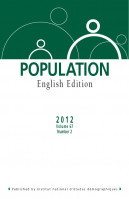
Population 2012, n° 2
2012
DEMOGRAPHY OF THE WORLD’S REGIONS: SITUATION AND TRENDS
- The Demography of Canada and the United States from the 1980s to the 2000s. A Summary of Changes and a Statistical Assessment - Magali Barbieri, Nadine Ouellette
ARTICLES
- The Demography of China’s 1958-61 Famine: A closer Examination - Zhongwei Zhao, Anna Reimondos
- Induced Abortion in Lomé, Togo. Trends and Role in Fertility Decline - Afiwa N’Bouke, Anne-Emmanuèle Calvès, Solène Lardoux
BOOK REVIEWS
- Historical demography and history of populations
The Demography of Canada and the United States from the 1980s to the 2000s. A Summary of Changes and a Statistical Assessment
Magali Barbieri, Nadine Ouellette
Canada and the United States have enjoyed vigorous population growth since the early 1980s. Although mortality is slightly higher in the United States than in Canada, this is largely offset by much higher fertility, with a total fertility rate at replacement level, compared with just 1.5 children per woman in Canada. The United States is also the world’s largest immigrant receiving country, although its immigration rate is only half that of Canada, where today one person in five is foreign-born, versus one in eight in the United States. Based on recent trends in fertility, mortality and international migration, the populations of these two North American countries will continue to grow over the next five decades, but at a progressively slower pace. The most acute demographic issue today is not, as in Europe, that of imminent population decline, but rather of the geographic and social inequalities which have increased steadily since the early 1980s and which are reflected in major fertility and health differentials between regions and social groups.
This article is accessible online in the "Download(s)" box
The Demography of China’s 1958-61 Famine: A closer Examination
Zhongwei Zhao, Anna Reimondos
One of the largest famines in human history took place in China half a century ago. This disaster, lasting from 1958 to 1961 in many areas, resulted in a huge number of excess deaths. While the causes, magnitude and profound impacts of this catastrophe have been brought to light in recent decades, many issues about the famine remain to be adequately examined. This paper aims to fill some gaps in our knowledge about the demography of China’s great famine. It concentrates on the demographic consequences of the famine and individual demographic responses in some of the most severely affected provinces. By analysing demographic data collected by China’s 1982 and 1988 national fertility sample surveys, the study provides further insights on changes in marriage, mortality, fertility and pregnancy outcomes during the famine period. The study reveals a dramatic increase in mortality and a decrease in marriage and fertility during the famine period, which had a significant impact on Chinese population. There were remarkable differences, however, in the demographic consequences of the famine between urban and rural areas and in demographic responses between people with different social and demographic characteristics. These findings are very important in improving our understanding of past demographic behaviour.
Induced Abortion in Lomé, Togo. Trends and Role in Fertility Decline
Afiwa N’Bouke, Anne-Emmanuèle Calvès, Solène Lardoux
Despite recent modifications, the Togolese law on abortion remains restrictive, and most induced abortions are practised illegally. By combining an indirect (residual) method with a direct one, this study analyses abortion trends in Lomé, the capital of Togo. It also looks at changes in the timing and prevalence of abortions across different cohorts. Lastly, it establishes the relative role of abortion in the fertility decline observed in Lomé. The article uses data from the 1988 and 1998 Togo Demographic and Health Surveys (DHS) and from a 2002 survey on family planning and induced abortion in Lomé (Enquête sur la planification familiale et l’avortement provoqué à Lomé). The results suggest that abortion is increasing in the Togolese capital city. The number of abortions is particularly high among younger cohorts, who are more likely to have abortions than older women at the same ages. It would seem that abortion, which mainly occurs early in a woman’s reproductive life, is being used as a form of birth control, resulting in a reduction of at least 10.8% in potential fertility.
Prix TTC : 20,00 €

